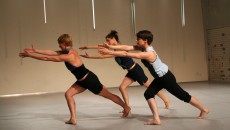In the heart of Berlin one will find the Tanzfabrik, center for contemporary dance. Since 35 years it offers space for rehearsals, production, artistic and theoretic research, advanced workout, further education, workshops and regular classes. It is also well known within the international dance scene as a production platform for contemporary dance in all of its diversity of choreographic and performative approaches.
In 2005, Tanzfabrik went international and joined the European network apap for a broader artistic exchange and the development of a larger financial base. Since 2010, Tanzfabrik grew bigger in the Uferstudios. Born out of a private initiative, the Uferstudios project transformed an area of 10000 sq m. of industrial halls and offices in a space for dance production, presentation and education.
For the concept’s implementation the national Lottery Foundation allocated a financial support of 4.3 million euros under the conditions of a long term perspective- initially it was signed a 25 years rent contract. Later on the Uferstudio’s director renewed the negotiations of contractual terms, fact that leaded to the current status of a 198 years lease contract. 14 dance studios, offices, seminar rooms, a media library with all required facilities are waiting for dancers and students and spectators in Berlin Uferstrasse.
About the development of the Tanzfabrik in the last 35 years we interviewed the artistic director, Ludger Orlok. He joined the Tanzfabrik in 2000 as head of production for the dance festival Tanznacht Berlin at its first edition. In the following years he coordinated more and more artistic projects in Tanzfabrik to become in 2007 in charge with the artistic direction of the dance centre and member of its board of directors.
Mara Nedelcu: In 2013 Tanzfabrik Berlin is celebrating its 35th Jubilee. There are 35 years of dance history written around its Studios. What led back in those times to the foundation of the Tanzfabrik? Was the initiative born out of a vision or was rather the natural evolution of a booming dance scene? Which role did the social and political context play?
Ludger Orlok: A deserted factory floor was a usual Berlin landscape in the late 70s and so for the artists it was a pretty normal initiative to occupy it. A very important role in deciding the faith of the bricks building in the Berlin Möckenstraße played the owner himself. Dr. Joachim Rust was during those times the manager of the Ullstein legacy and is still nowadays representing the interests of the Axel Springer Foundation in Ullstein legacy matters *.
1978 is representative as a founding year for the Tanzfabrik and even beyond. All around Germany and particularly in Berlin there was a time of rising for the alternative political movements. That led to the founding of the left oriented alternative newspaper die taz, today one of the most important Berlin newspaper, as well as the kick-off for the ecological party Die Grünen and so on.
Those years were also known to be a very intense phase for the activists of the RAF-Red Army Fraction after the death of Baader – Meinhof in Germany. There were times of a new revolution which, after the 1968’s movements, was marking the first steps in establishing an alternative lifestyle but on the other hand, unfortunately, also the increase of left wing radical’s violence.
Claudia Feest, one of the Tanzfabrik Berlin co-founders, describes the group of founders as dancers, which were rebelling against the classical manners and dance regulation, sportsmen, which were dedicated to arts and some others, which hade a strong background in the field of natural science. All of them tried to find an individual and body related way to contra balance the social protest. Inspired by the post modern dance movements of the American west coast, especially the contact improvisation scene, she developed a work of research, production and teaching with an artists collective which she was personally running until 1995 in the Tanzfabrik in the famous neighborhood of Berlin, Kreuzberg.
The times of the birth of Tanzfabrik are relevant in the modern history of German dance for its effervescent evolution. Pina Bausch’s Tanztheater in Wuppertal was gaining its fame and in the same time was redefining the dance in state theaters. Meanwhile in Berlin, some of the participants of the dance cultural and political scene were making the first editions of the festival Tanz im August possible. In a broader context, this development is related to the alternative ideals and visions of the dance scene in the 20s in Berlin, revitalized in the 60s after WW II.
MN: How can you describe the transition of Tanzfabrik from a dance collective to a dance school and a venue for contemporary dance performance? And how did the development of the Berlin dance scene have an influence in this process?
LO: Already during its early years the Tanzfabrik company got the Studio venue full with spectators, who were attracted by the novelty of that kind of dance performance. Together with the development of the performance scene, the popularity of the company increased and it was need for a bigger venue to replace the Moeckernstraße Studio. And so the shows of the company were hosted in the Hallesches Ufer Theater (today HAU nn.). While more and more choreographs were looking for spaces and resources for their productions, the Senate of Berlin was allocating more funds for the independent scene, along with the redistribution of the already existed in order to finance new-born initiatives. After the fall of the Wall in Berlin, venues like DOCK 11 and others were founded. This development led during the 90s to a new financial concept and a change in the subventions structure for the local cultural scene. In 1995, Tanzfabrik was going through a structural change caused by a subventions cut of 50%. The organizational structure was modulated according to the different kind of activities in the Tanzfabrik: the artistic department, the school and the management level. Since 2005, Tanzfabrik Berlin is part of the European network apap (advancing performing arts project) and so it got stronger on an international market.
MN: The collaboration in the Uferstudios opened a new chapter for Tanzfabrik. What expectations you have from this partnership?
LO: Together with the three university dance study modules, the Tanzfabrik actively participated to the founding and development of the Uferstudios. Besides playing the role of administrator for two of the studios – one of them the second biggest presentation venue in the area – the Tanzfabrik is also the main shareholder of the Uferstudios GmbH. Therefore it is responsible for the further development of the project under the concept of a partnership for several dance institutions. This diversity is essential for the Uferstudios and has to benefit of support and protection as well as Tanzfabrik in its development as a producer and patron of dance and performance.
MN: What is the financial situation of the Tanzfabrik today and how important is the international networking in this matter?
LO: Even today there are still not fix available financial resources either for our collaborators of the artistic production department and residency program (for example artistic director, production manager, technical manager, PR responsible) nor for production funds and full residencies with free studio space and financial support for the artists in residency. The European network apap makes it possible to have an apartment available for our guest artists. The international visibility of Tanzfabrik is growing. 28.000 euro out of the EU Cultura project can be directly offered to the artists to support their projects.
*From Kreuzberger Chronik, extract, edition 130, September 2011
“… The grandeur of the past was lost in the war, but Dr. Hans Joachim Rust, the executors of Heinz Ullstein, manage to obtain in 1976 the property of the buildings on the Möckernstraße in order to fulfill the last wishes of the deceased. Heinz Ullstein, a sun of the famous publishing family, but also a passionate actor and theater director, was the only member of the family, who did not flee from the Nazis. Heinz married the daughter of the writer, director and theater director Ernst Gettke. Persecuted by the Nazis and reassigned to clean the S-Bahn garniture by night, Ullstein survived only with the help of friends who hid him away.
According to his last will, Heinz Ullstein offered his heritage in favor of “actors in need”. The executor and the Axel Springer Foundation gave the house the name of the theater director Gettke and started in the seventies to set up studios and cultural establishments in the factory floors. To the ground floor of a prestigious villa moved the gallery Dümmen, the only inhabitants of the villa was his butler. In the backyards moved in the artists, an advertising agencies, architects and “astrologers and belly dancers, swimming diving, students and alternative residential communities”. Since thirty years, the Kreuzberg Tanzfabrik is located on two floors in the old factory building…. “

